Lighting for Humans
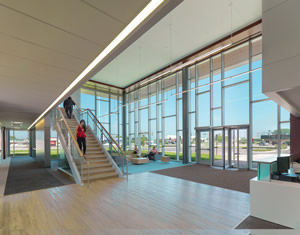
ARCHITECT: DEMONICA-KEMPER ARCHITECTS / PHOTO © JAMES STEINKAMP PHOTOGRAPHY
The advent and adoption of LED lighting revolutionized how designers illuminate indoor and outdoor spaces. The technology entered the market in the early aughts touting two great benefits: they use less energy and last much longer than incandescent or fluorescent bulbs. But there was a downside. LEDs were expensive and early iterations had variable quality and reliability.
Over time, the price point has gone down while quality improves. Today’s LEDs are also color tunable and fully controllable, allowing more personalization and better energy savings than ever before. “LED technologies are increasingly capable of delivering just the right light, at just the right time, says Bill Marushak, CSP, national sales manager for College and University Programs, Lutron Electronics Co., Inc.
LEDs have even fostered the concept of Human Centric Lighting, a design trend that leverages the technology’s benefits to create the most comfortable, flexible, and productive spaces. “Human-centric implies that we’re designing light to really enhance health, well-being, and productivity,” according to Vivian Loftness, professor of architecture, Carnegie Mellon University.
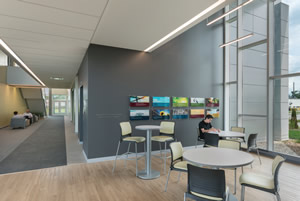
ARCHITECT: DEMONICA-KEMPER ARCHITECTS / PHOTO © JAMES STEINKAMP PHOTOGRAPHY
Even with all of its benefits LEDs are not universally found on college campuses. “Consider that over 55 percent of existing campus buildings have not been renovated in more than 25 years,” according to Marushak, who quotes State of Facilities in Higher Educations: 2016 Benchmarks, Best Practices, & Trends. “That means fluorescent lighting is still prominent in a majority of campus buildings.”
Those renovations are coming. And they will undoubtedly bring LEDs into the lighting mix. Here’s some examples of how this technology can be used in the learning environment.
Human Centric Lighting: A Primer
Human Centric Lighting (HCL) is a lighting system that focuses on the end user. The concept has four key aspects, according to Brent Protzman, director of building science and standards development, Lutron.
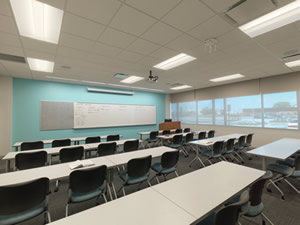
ARCHITECT: DEMONICA-KEMPER ARCHITECTS / PHOTO © JAMES STEINKAMP PHOTOGRAPHY
1. Access to daylight: Natural light and access to views are something we all crave. “Views used to be stigmatized as a distraction,” says Protzman. “But that connection to nature is comforting. It makes us more focused and productive.”
2. Dynamic light: Interior lighting is designed to change throughout the day. Color and intensity shift to mimic the hour.
3. Personal control: Occupants have the ability to brighten or darken a room based on their personal preferences and the needs of the space. Professors can dim lights for presentations or brighten them for energetic discussions. The changes don’t need to be dramatic to get the effect but “just having access to control makes occupants feel more connected to a space,” Protzman says.
4. Quality of light: The light must “feel right,” according to Protzman. “Do they hum or strobe when you dim them?” If so, the lighting is not right.
Randy Burkett, of St. Louis-based Randy Burkett Lighting Design, defines HCL simply. “It’s just being sensitive to human needs and human desires, whether it’s in an office space, in a hospital, in a classroom, or out for a good night on the town.”
LEDs Make It Possible
“With the advancement of LED technology and the ability to control light output and color temperatures, college administrators and facility managers are growing increasingly curious about how this new technology can be effectively utilized in the learning environment,” says Michael McCullough, director of public relations, Hubbell Lighting.
As a result, any new or renovated building will undoubtedly feature LEDs. “In 2015, 70 percent of lighting was fluorescent,” says John Dellorto, vice president of Sales, Focal Point. “In 2019 it’s under 2 percent.”
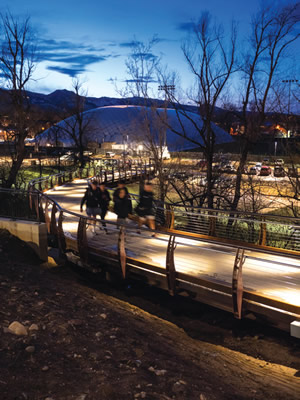
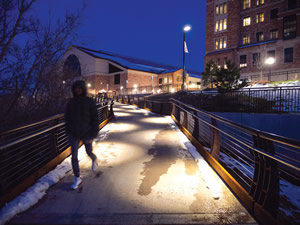
PHOTOS COURTESY OF THE UNIVERSITY OF COLORADO BOULDER
LIGHT UP THE NIGHT. When replacing two pedestrian bridges on the campus of the University of Colorado Boulder, consideration was given to a nearby housing complex, as well as a bird migratory path above the bridges’ location. Motion-activated LEDs embedded into the bridges were installed that ensure the safety of pedestrians while minimizing light pollution to the area.
LEDs are the light source of choice for reasons beyond their energy savings and long life.
“The advantage of LEDs is they are inherently controllable and can be used with digital control systems that offer simple, proactive scheduling systems, and the ability to rezone/reprogram lighting without rewiring or opening up walls,” says Marushak. “Smart lighting and control solutions will be the standard on virtually any campus, and LEDs will be integral in every space.”
All of this control makes the energy-saving technology even more efficient. LEDs allow colleges to participate in Demand Response (DR) programs offered by their local utility. With DR, a school may be called on to curtail its energy use during high-use peak hours, often for a cash incentive. Well-controlled LEDs can help shave that peak without losing functionality.
They can also change color temperature within a single luminaire to create various environments and effects. “Teachers and administrators now have the option to customize the learning area to produce a more cohesive learning environment,” says McCullough. He points to a study from the Lighting Research Center at Rensselaer Polytechnic Institute which proved that robust morning light improves sleep and mood as well as lowers stress in office workers. “Providing educators with the ability to ‘warm’ the color temperature of the lighting in the space has the potential to aid calming or settling actions for students just as tuning the light to a ‘cooler’ color temperature containing more blue light could potentially help with focus.”
University of Colorado Boulder Bridges the Night
LEDs were the right solution for Richelle Reilly, campus landscape architect for the University of Colorado Boulder. She was tasked with replacing two pedestrian bridges washed out by flooding in 2013. The structures serve as an important pedestrian thoroughfare, logging 3,000 crossings during the busiest hours. Without them pedestrians were detoured to a path a quarter mile away at the edge of campus. An inconvenience for sure; students were put off by the hassle and often chose driving over walking.
Replacing the bridges gave Reilly the opportunity to address issues created by the traditional illumination solutions. Pedestrian poles lit the path well, but they spilled unnecessary light on the graduate housing complex below. They also beamed light directly up into the night sky, a problem as the corridor is one of the busiest bird migratory paths in the city.
Reilly abandoned poles entirely, instead embedding LEDs in the bridges’ hand rails. Attached to a sensor, the lights go dark when no one is around. Once a pedestrian approaches, the path is illuminated with safe light levels that do not spill into the residential complex below or the dark night sky above.
MORAINE VALLEY COMMUNITY COLLEGE
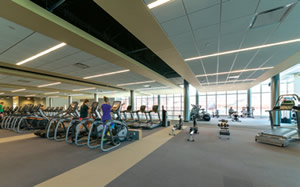
PHOTO © JAMES STEINKAMP PHOTOGRAPHY
Tasked with replacing an undersized health center, Moraine Valley Community College, in Palos Hills, IL, called on Demonica-Kemper Architects to create a $35-million, 13,000-square-foot facility to serve their 36,000 students along with employees and community members. The contemporary structure balances natural and artificial light throughout. The lobby features a change in the ceiling plane to differentiate areas. Recessed LED luminaries integrate seamlessly with the grid ceiling to eliminate visual clutter and support the modern aesthetic of the space.
This article originally appeared in the College Planning & Management April/May 2019 issue of Spaces4Learning.